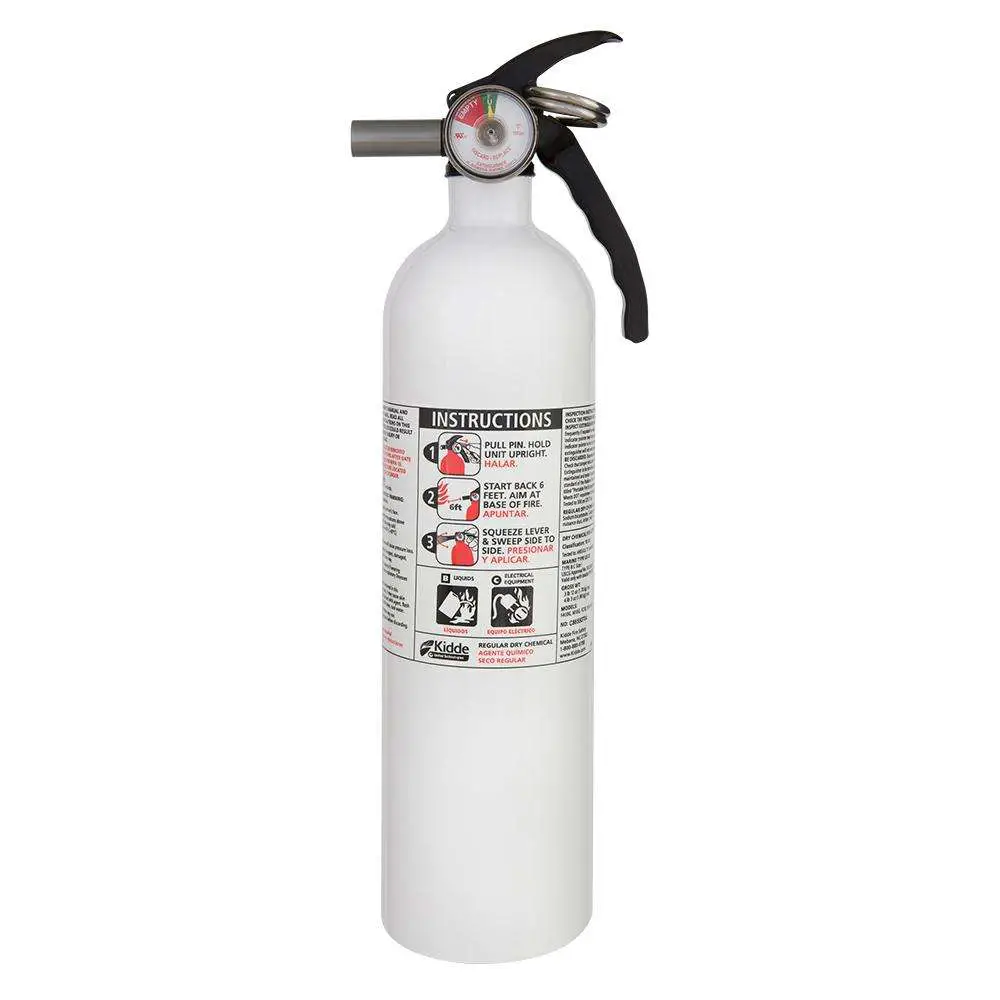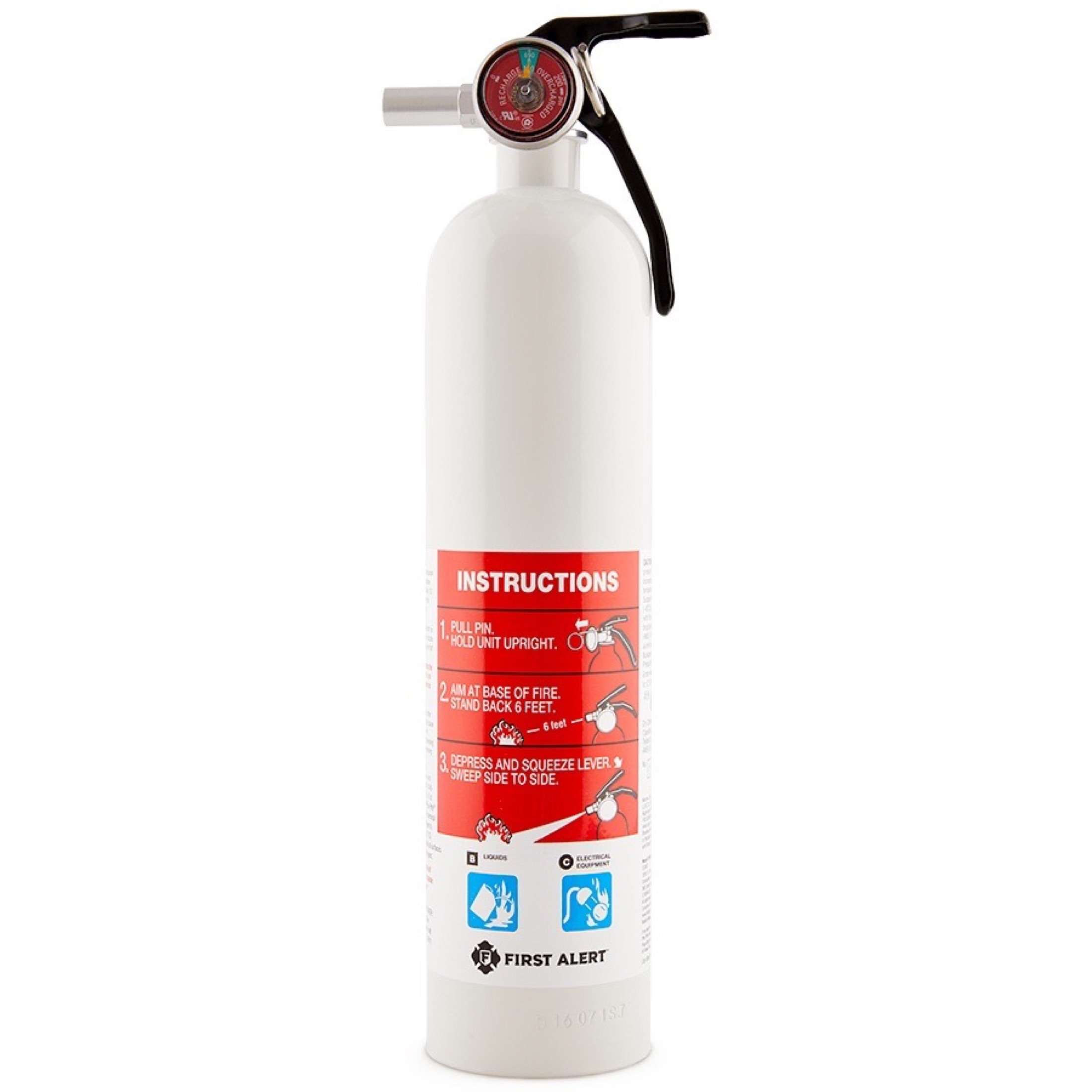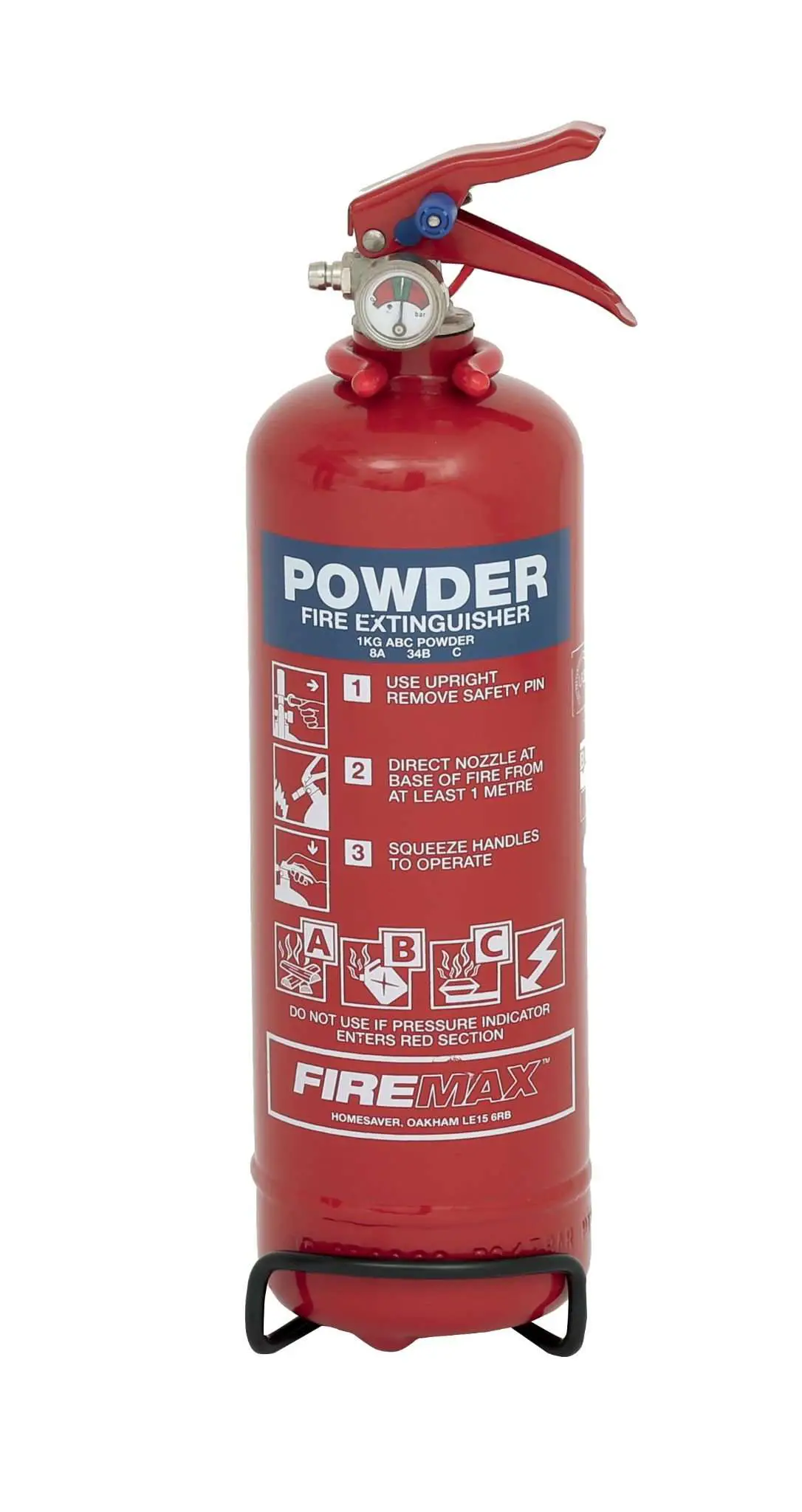Boat Fire Extinguisher Placement
NFPA 10s requirements for the placement of fire extinguishers are all about ease of accessthey should be readily accessible and immediately available and located along normal paths of travel .
The core rule is that extinguishers should be located where they are easy to get to during a fire. This means putting them in places where people usually inhabit. If the visibility of fire extinguishers will be obstructed, their location should be clearly indicated , such as with a high-visibility decal.
A high-visibility fire extinguisher decal like this one can be used to mark the location of extinguishers.
Beyond this, NFPA 10 has rules for the minimum walking distance to the nearest fire extinguisher based on the hazard level and the fire extinguisher’s size.
Table 6.3.1.1 in NFPA 10 lists these distances, but you dont even need to consult the table unless you have a very large boat. Depending on the size of the fire extinguisher, it needs to be within 30 to 50 feet of any point on a vesselnot a problem for most recreational craft.
Which Fire Extinguisher Is Right For Your Boat
Extinguishers are classed by the type of fire they can extinguish efficiently:
Class A: Designed for combustible solid materials such as wood, paper, or textiles.
Class B: Designed for flammable or combustible liquid such as kerosene, grease, gasoline or oil.
Class C: Designed for use with electrical fires.
Class D: Designed for fires that involve flammable metals. This class of fire is not common like class A and B. Flames must be addressed to avoid rapid spread, intense heat, and excessive damage.
Class K: Designed for cooking fires such as those started by cooking oil, grease, animal and vegetable fats.
There are also tri-classed fire extinguishers available, that are all-purpose extinguishers that usually can take care of fires started by wood, flammable liquids, and electrical fires.
What Type Of Fire Extinguisher Is Best Onboard A Boat
No1. First Alert Rechargeable Marine Fire Extinguisher. This boat extinguisher has high recommendations and reviews on Amazon.
Recommended Reading: Oklahoma Boating Required Equipment
What Is The Fastest Way To Remove Water From The Bilge
A bilge pump is a water pump, used to remove water from the bilge of your boat. They are available in both manual, and electric designs: Manual Bilge Pumps are used to dispel water from your boat manually. Make sure the discharge hose is long enough to reach from the bilge to over the side of your boat.
What Are Fire Extinguishers Made Of

Fire extinguishers are made of an extinguishing agent and usually a pressurized gas such as carbon dioxide. The fire suppressant inside can be foam-based, water-based, wet chemical-based, carbon-dioxide based, and chemical powder-based.
Water-based: These are probably the least effective. Water is really only good for putting out paper or wood fires, and small ones at best. They are not that effective on boats when chemicals or a combustible like gasoline may be a factor.
Carbon dioxide: These extinguishers are environmentally safe as carbon dioxide is a clean, odorless gas. It is usually discharged from a fire extinguisher as a cloud of snow that suffocates the oxygen in the fire, causing it to go out.
Wet chemical: These consist of potassium salts that are sprayed out in a fine mist that creates a soapy film that suffocates the fire.
Powder: These extinguishers contain a heavy sodium chloride powder that when it makes contact with the heat of a fire, it cakes and forms an exterior crust, which excludes air and results in the fire going out.
Recommended Reading: How Do I Register A Boat In Florida
Tips On Choosing The Right Fire Extinguisher For Your Boat
An uncontrolled fire is one of the most frightening and devastating things that can happen on a boat. An onboard fire can double in size every 7 seconds, so having the right extinguisher in the right place can make the difference between a problem and a catastrophe.
All fire extinguishers are classified by a letter and a Roman numeral. The letter indicates the type of fire it is designed to extinguish. The numeral indicates the size of the extinguisher. The higher the numeral is, the larger the extinguisher will be. Sizes I and II are portable by hand, and sizes III, IV and V are semiportable.
Class A extinguishers are designed to fight fires that leave an Ash. This includes ordinary combustibles such as wood, paper, cloth, trash, and many plastics including the fiberglass reinforced plastic used for decks and hulls The best extinguishing agents for an A fire are water or chemical foam.
Class B fires Boil. They involve flammable or combustible liquids such as stove alcohol, grease, gasoline, diesel, kerosene, oil, oil based paint, teak oil, paint thinners, acetone, and varnishes. The best extinguishing agents for a B fire are carbon dioxide, dry chemical or aqueous film-forming foam .
Reasons To Store Fire Extinguishers On Your Boat
Dont forget that you have to be careful with combustible fuel in your boat. As long as you use the appropriate fuel stabilizer, substandard combustion wont occur while maintaining the cleanliness of the fuel system cleaner.
You can rely on fuel stabilizers like STA-BIL Storage Fuel Stabilizer, Star Tron Enzyme Fuel Treatment, and QuikSilver Quikstor Fuel Treatment.
Aside from the combustible fuel, the following reasons will oblige you to secure fire extinguishers on your boat.
- An enclosed area for cooking
- Permanently installed fuel tank
- Engine tanks are stored in seat compartments
- Some areas without a floatation device
- There are double bottoms that are not permanently used to cover the hull
The Number of Fire Extinguishers on Boats Required by the Authorities
You can correctly store the fire extinguisher in your boat if its in the required size. You dont need a bulky one that may give you trouble.
According to the US Coast Guard, the correct quantity of fire extinguishers that you have to get is based on your boats size. Here are some charts and guidelines to get the appropriate number and size of fire extinguishers for your boat.
| Extinguisher Type and Size |
| 15 | 10 |
Boats shorter than 26 feet dont need a fire extinguisher at all. However, they wont be released when used for the commercial purpose of carrying passengers and with the construction that can entrap flammable and explosive liquids or gases.
Also Check: Cost Of Freedom Boat Club Membership
Which Fire Extinguisher Is Right For Me
Extinguishers are classified according to the type of fire that they can put out with high efficiency.
Class A is made for solid combustible material, like wood, textiles, or paper.
Class B is made for combustible liquids. This is more suitable for kerosene, gasoline, oil, or even grease.
Class C is strictly for electrical fires. No other class will put out a fire nearly as efficiently as a Class C.
Class D is for fires that are made by flammable metals. This isnt a common cause, and those fire extinguishers will usually not be needed on your boat.
Class K is sometimes found in boat kitchens. Theyre made especially for fires that are made by cooking oil, grease, or animal/vegetable fats.
Youll be ensuring maximum protection if you opt-in for a tri-classed fire extinguisher. This is an all-purpose extinguisher thats made to take care of any fire that starts, whatever the source of it is.
Where To Mount A Fire Extinguisher In A Boat
Fire extinguishers should be mountedin an angle on a boat to avoid any damage to it. And at the same time it shouldbe place where anyone can easily access in case of any emergencies.
Lastly, make sure your fire extinguisher is maintained regularly. Always check to be sure that it isnât leaking or damaged as any errors may render it ineffective, and cause irredeemable damage and loss.
You May Like: Noaa Beacon Registration Renewal
Where Should Fire Extinguishers Be Stored On A Boat
The US Code of Federal Regulations actually makes no comment about where and how fire extinguishers should be stored on a boat. After all, it cites NFPA 10 , which provides all the essential information about fire extinguisher storage.
Lets take a brief look at where and how fire extinguishers should be stored according to NFPA 10.
Boat Fire Extinguisher Requirements
The law requires every boat owner to have an extinguisher on board if their boat meets the following conditions:
Although it is advisable to have extinguishers on all kinds of boats, it is not really a requirement by law.
Also Check: What’s My Boat Worth
Fire Extinguishers For Boats Buying Guide Reviews And Comparison
If you have a busy schedule and you find it hard to dedicate some time to researching information for your hobby, you may find buying gear to be a daunting task. However, if you need help, feel free to check our suggestions, since weve read dozens of fire extinguisher reviews in order to put all these tips together. Stick to our advice if you want to make sure you buy the best marine fire extinguisher. According to our findings, the first product that you should consider is the Kidde 10 B-C Mariner, due to its extremely useful properties. For example, its discharge time is as quick as 8 to 12 seconds, while the range goes up to 6-8 feet, making this item very efficient in putting out a fire. Its UL listed and rated 10 B-C so its safe to use it for any type of flammable fuel. Should this product be unavailable, we strongly advise you to try the First Alert AF400 Tundra as an excellent alternative.
Boats Larger Than 65 Feet

For boats larger than 65 feet, federal requirements must be met. This often means installing an actual fire extinguishing system. Fixed fire systems are rated by cubic feet of coverage, so you will have to have your engine room measured. Inside the fixed fire-extinguishing system are fire suppressants, which are usually stored as a liquid, but which are emitted as a gas.
Fixed systems trigger automatically with a temperature sensor, or can be set off manually, if necessary. However, if the fixed system triggers while you are moving, you will need to react quickly. You will need to shut off engines, blowers, generators, and other equipment, or they may need fresh oxygen to restart and to expel fire suppressant.
In addition, boats larger than 65 feet may also require a ventilation system for each compartment in the boat that contains:
A permanently installed gas engine
Openings between it and a compartment that requires venting
A permanent fuel tank and an electrical component that is not ignition-protected
A fuel tank that vents into a compartment and/or
A non-metallic fuel tank.
This U.S. Coast Guard requirement applies to all boats built on or after August 1, 1980. The boat owner is responsible for making sure openings are free of obstruction, ducts are not blocked or torn, blowers operate properly, and worn components are replaced with Coast Guard-approved equipment.
Don’t Miss: How To Find Expiration Date On Coppertone Sunscreen
Number Of Fire Extinguishers Needed On Motor Vessels
Only really big boats are classified as motor vessels. Because these vessels have large engines and carry more fuel, more fire extinguishers are required. The number of extinguishers needed depends on two factors: weight and the size of the engine .
The standard size of a fire extinguisher for a motor vessel is 20-B, and every motor vessel needs at least 1. CFRs Table 25.3020 lists the number of 20-B extinguishers required:
The more your motor vessel weighs, the more fire extinguishers it must carry. At least one 20-B fire extinguisher is required no matter how much a motor vessel weighs. Source: Code of Federal Regulations
The large engines of large vessels need extra protection. On top of these rules, add another 20-B extinguisher for every 1,000 BHP of the vessels engine. All engines between 1 BHP and 1,000 BHP require 1 additional extinguisher. At 1001 BHP, 2 more extinguishers are added.
One more level of protection is required for very heavy boats. Any vessel over 300 gross tons must have either:
- One 160-B semi-portable fire extinguisher, or
- A fixed fire extinguishing system in the machinery room
Semi-portable fire extinguishers are large, heavy, and must be moved on wheeled dolliesa big inconvenience. A fixed fire extinguishing system provides extra safety, plus relieves you of the burden of storing and maintaining semi-portable fire extinguishers.
Fire Extinguisher Boat Requirements Canada
Different types of fires can occur on a motori boat, and each type of fire requires a different type of extinguisher. A motor boat should have a type BC fire extinguisher on board capable of fighting combustible liquid and electrical fires. The letters on a fire extinguisher determine what types of fires it is designed to fight. Fires are classified as follows:
You May Like: How To Remove Mold From Boat Carpet
Requirements Of Fire Extinguisher On The Boat
Here we suggest you which types of fire extinguisher and how many fire extinguishers do you need on your boat. The Coast Guard recommends that, keep a minimum of one B-1 marine fire extinguisher on your boat. But depending on your boat size, you may need to increase the quantity of fire extinguisher.
If your boat length a minimum of 26ft then you need one B-1 fire extinguisher. If your boat length is 26 ft 40 ft then you need to install two B-1 or one B-2 fire extinguisher. And if your boat length is 40ft 65ft then install two B-2 or three B-1fire extinguishers.
The required numbers of extinguisher may be reduced if your boat has an engine compartment fire extinguisher system installed for protection approved by USCG.
Fixed Fire Extinguishing Systems
Instead of using a portable fire extinguisher, the master may fit their vessel with an approved fixed fire extinguishing system to the enclosed engine compartment, as long as it is of the equivalent size.
If the vessel must have multiple extinguishers, the fixed fire extinguishing system must be equivalent to the nominated portable fire extinguisher size and the additional portable fire extinguishers can be any size.
Recommended Reading: Aaa Trailer Coverage
H3r Performance Hg100c Halguard Chrome Clean Agent Fire Extinguisher
The HG100C fire extinguisher is an excellent and smart-looking clean agent fire extinguisher with excellent color. It may increase your boat decoration. Its cylinder made by high-quality steel also all-metal valve construction Includes steel strap and mounting bracket.
Basically, it made for Boat, RV, sports cars and aircraft. But it could be used in your shop, garage also any other place. It is an environmentally safe fire extinguisher. It extinguishes without any damage or sketch.
The HG100R fire extinguishers weight is 1.4lbs and fight with wood, paper, cloth, flammable liquid, gas, oil, the engine also electrical fire. It is very easy to use and the discharge rang is 6 feet 8 feet. This 100% rechargeable EPA approved extinguisher made in the U.S.A.
Where Is The Best Place To Store A Fire Extinguisher On A Boat
Experts suggest that storing the fire extinguishers by vertically and wall mount where they are easily accessible for all people. That means keep them in your boat where fires are likely to spread, just like cabin, kitchen, hull, and the bilge and beside the engine.
- Inspect every month to determine whether it still has pressure.
- It should be replaced or recharged right away if the gauge shows low or empty.
- When you see it doesnât pop back up after it is pressed, that means the pressure is too low and it needs to be replaced.
- Dry powder or dry chemical extinguisher needs to shake a few times in every month. So that, the powder is kept loose.
- Do not pull the pin if there was no fire.
- Maintain the instruction labels and inspection tag.
Recommended Reading: How Does Freedom Boat Club Work
Where Should Fire Extinguishers Be Stored On A Boat & How
When you are out on your boat, whether for a pleasure cruise with friends or by yourself to enjoy the water, you should always think about safety first and that includes keeping a fire extinguisher on board. The question is, where should fire extinguishers be stored on a boat? Lets talk and discuss in details.
What Type Of Extinguishing Agent

Water Good for Class A fires. Extinguishers are heavy, difficult to store, and are NOT for use on flammable liquid or electrical fires.
Carbon Dioxide Good for Class B and Class C fires. No residue. Easy to use. Useful only in confined interior spaces. Does not cool fire.
HFC-227ea Relatively non-toxic Halon replacements are effective on all fire classes. Expensive.
New 3M agent is an environmentally-sustainable replacement for HFC-227 or FM200. No potential damage to the ozone layer or global warming potential. Effective on all fire classes and leaves no residue after use.
Halotron 1 EPA-approved. Safe for computers, electronics, even clean rooms, and leaves no residue after use.
Dry Chemical Low toxicity. Inexpensive. Effective on Class B and Class C fires. Not effective on Class A fires. Difficult to clean up.
Tri-Class Dry Chemical Low toxicity. Inexpensive. Effective on Class B and Class C fires. Moderately effective on Class A fires. Difficult to clean up. Corrosive. Not a good choice for helm or nav station.
Aqueous Foam This relatively new technology is extremely easy to use effectively on Class A, B, and C fires. Avoid excessive skin or eye contact.
BoatU.S. tested fire extinguishers in 2009. View their highly informative series of seven short videos.
Read Also: Boat Seat Cleaner For Mildew
